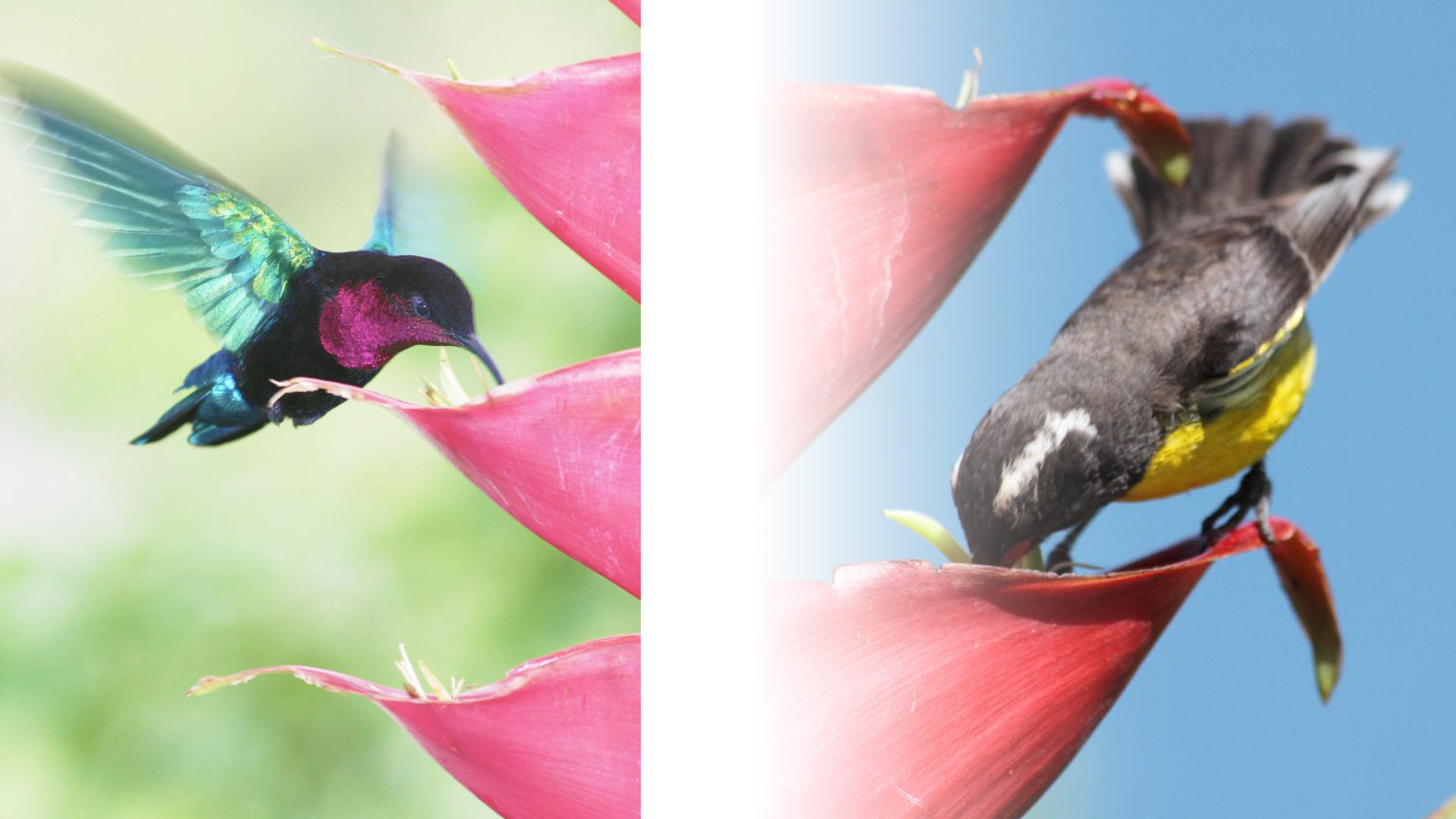

Visiting heliconias: left, a Purple-throated carib (Eulampis jugularis) and right, a Bananaquit (Coereba flaveola) (photos: Ethan Temeles/Amherst College)
Hurricane Maria killed so many Purple-throated caribs, sole pollinator of two species of heliconia, that other birds were able to gain access to the plants, according to an article in New Phytologist, which concludes that species extinction is a far more complex process than is often thought.
Hurricane Maria killed so many Purple-throated caribs, sole pollinator of two species of heliconia, that other birds were able to gain access to the plants, according to an article in New Phytologist, which concludes that species extinction is a far more complex process than is often thought.

Visiting heliconias: left, a Purple-throated carib (Eulampis jugularis) and right, a Bananaquit (Coereba flaveola) (photos: Ethan Temeles/Amherst College)
By José Tadeu Arantes | Agência FAPESP – Most flowering plants depend on animals for pollination. In warm wet tropical regions, more than 90% of plant species are pollinated by animals. In Dominica, a Caribbean island country, researchers have identified a mutualistic relationship between two species of heliconia plant (Heliconia bihai and H. caribaea) and their hummingbird pollinator, the Purple-throated carib (Eulampis jugularis). The association is so specific that it has often been cited as an example in the scientific literature.
For this reason, when Hurricane Maria (category 5, the highest on the Saffir-Simpson scale, with sustained winds of more than 250 kph) struck the region in 2017 and killed 75% of the entire E. jugularis population, these two species of heliconia were expected to become extinct.
However, a scientific paper recently published in the New Phytologist shows that other birds have become pollinators of the plants in question. The authors are based in Brazil, Denmark, Switzerland, United States and United Kingdom, with an important contribution by the Center for Research on Biodiversity Dynamics and Climate Change (CBioClima), a Research, Innovation and Dissemination Center (RIDC) supported by FAPESP and hosted by São Paulo State University (UNESP) in Rio Claro, Brazil.
“In 2022 we studied the region in great detail, analyzing bird-heliconia visitation types and rates, as well as pollen deposition and transportation patterns. Our findings pointed to drastic changes: other hummingbird species and also the Bananaquit (Coereba flaveola) had begun to visit and pollinate heliconia flowers at similar rates to E. jugularis or even higher,” said Fernando Gonçalves, a member of CBioClima and currently a postdoctoral researcher affiliated with Jordi Bascompte’s laboratory at the University of Zurich (UZH) in Switzerland.
“Our analysis suggested that the decline in the population of E. jugularis resulted in a breakdown of the competitive exclusion of other species and allowed other birds to become effective pollinators. We concluded that specialized pollination systems can become generalized after natural disturbances such as hurricanes, showing that the ecosystem was resilient,” he said.
Birds were captured near heliconia plants using mist nets (made of nylon or polyester mesh suspended between two poles, resembling a volleyball net), and pollen stuck to their beaks and feathers was sampled using a special jelly. Cameras enabled the researchers to identify the birds as they visited the plants, and pollen deposition was measured by flower stigma inspection after visitation.
“E. jugularis is highly territorial and aggressive. When the population was large, no other bird species could get near the heliconias, but once the population had been reduced to only a quarter of its original size, there weren’t enough individuals to keep other hummingbird species and the Bananaquit away from the plants. These new pollinators are generalists. They collect pollen from several plant species. And the Bananaquit feeds on fruit,” Gonçalves said.
This discovery was significant for two reasons. First, it was thought that only E. jugularis could pollinate H. bihai and H. caribaea because the shape of their flowers matches the size and curvature of this hummingbird’s beak. Females of E. jugularis have long curved beaks and are the main pollinators of H. bihai, while H. caribaea is pollinated by both females and males even though the latters’ beaks are shorter and straighter.
The second and even more important reason for the importance of the discovery is that it showed species extinction to be a far more complex process than is often thought. The devastation left in the wake of Hurricane Maria interrupted the co-adaptation and co-dependency of plants and hummingbirds, letting other birds take their place. Evolutionary paths may meander instead of being highly linear. This is particularly relevant in the context of the ongoing climate crisis, in which extreme events such as severe drought, torrential rain, floods, hurricanes, etc. are more frequent and species are becoming extinct in a comparatively short time.
“If no other mass destructions occur on Dominica, we believe the two species of heliconia and E. jugularis may reestablish their exclusive mutualism in 15 to 20 years or so. The population of E. jugularis will have grown again, and there will be plenty of individuals defending their territory,” Gonçalves said, adding that his team is conducting more research in the area to test the hypothesis. They also plan to assess the impact of natural phenomena on the evolutionary behavior of other species. “We’re on the lookout for hurricanes in the region so we can go back there and investigate the consequences.”
The article “Hurricane-induced pollinator shifts in a tightly coadapted plant–hummingbird mutualism” is at: nph.onlinelibrary.wiley.com/doi/full/10.1111/nph.19938.
Republish
The Agency FAPESP licenses news via Creative Commons (CC-BY-NC-ND) so that they can be republished free of charge and in a simple way by other digital or printed vehicles. Agência FAPESP must be credited as the source of the content being republished and the name of the reporter (if any) must be attributed. Using the HMTL button below allows compliance with these rules, detailed in Digital Republishing Policy FAPESP.





